
|
Sale 17
Coin Auction
| U.S. Patterns (1838-1868) |
| |
| |
| Lot |
Photo |
Description |
Realized |
Lot 1783 |
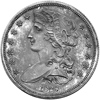 |
1838 Pattern Half Dollar. Silver, reeded edge. Judd-72. Pollock-75, Rarity-5. PCGS graded Proof 64. While PCGS does not differentiate, we suspect that this might be an original instead of a restrike, but we can't weigh the coin to determine for sure, as the strike is full on all but the uppermost central curls above the ear of Liberty and we see no traces of die rust or cracks, which appear on most of the restrike issues. To determine if this is a restrike or not, the coin must be weighed, 206 grains for an original (see the Pollock reference for more details) which is very scarce. 192 grains for a restrike, and both have the 360 degree reverse alignment (medal turn as opposed to coin turn).
The coin itself is toned a lovely steel gray with hints of lilac and gold, very even on both sides. Scrutiny will note faint hairlines in the fields, but these are not detracting. Razor sharp on the stars and most of the curls on Liberty, with the slightest weakness noted below TY and around the ear. On the reverse, the die engraving and strike are superb, with every minute feather detail sharp on the eagle. PCGS has graded 6 this high, with only 2 graded higher, both PR-66.
Historically, this coin marks the passing of the torch from Mint Engraver William Kneass to Christian Gobrecht. Kneass suffered a stroke in 1835 which left him partially incapacitated, and this is the last obverse die executed by him prior to his stroke (Judd refers to a letter from Mint Director James Ross Snowden confirming this fact), apparently undated and finished in 1838. The obverse features a matronly Liberty facing left, with long curly hair cascading down her back, neck and even underneath the shoulder of her bust. Liberty sports a sunburst tiara, although becoming, was not used on any regular issue coins. The reverse die is attributed to Christian Gobrecht, and features a stylized eagle. During his brief tenure, Kneass developed the raised blank rim and beaded boarder on the dime (1828), and these were incorporated on the half dime and half dollar in 1829. Kneass was known for his quickness and efficiency, and made an excellent combination with Christian Gobrecht. The stroke which Kneass suffered in 1835 forced him to more menial tasks, and he passed away in 1840 (PCGS # 11282) .
Estimated Value $4,000 - 5,000.
From the Benson collection and purchased from Ira S. Reed on April 27, 1945 for $30.00.
View details and enlarged photos
Check results on similar lots
| Realized
$5,520 |
Lot 1784 |
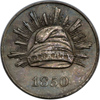 |
1850 Pattern Three Cents. Silver, plain edge. Original. Judd-125. Pollock-147, Rarity-4. PCGS graded Proof 64. Deep lilac and blue toning on both sides over the silvery surfaces. Well struck save for the central portion of the cap, which shows minor weakness. This design is an obvious copy of the Republic of Mexico coinage current at the time. The dies and design engraving are attributed to Franklin Peale after he had viewed Longacre's pattern for the denomination. Pollock notes that the planchets for this issue were cut from a metal strip with uneven thickness, so weights range from 10 grains to 13.7 grains. The reverse incorporates a curled palm frond with the denomination III at the center. This particular one is much better than most, with PCGS reporting 6 this high, and just 1 coin graded higher (PCGS # 11536) .
Estimated Value $1,200 - 1,500.
From the Benson collection and purchased from Hollinbeck Stamp & Coin Company as lot 1334 on December 8, 1945 for $9.00.
View details and enlarged photos
Check results on similar lots
| Realized
$2,645 |
Lot 1785 |
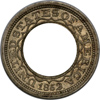 |
1852 Pattern Gold Dollar. Copper-nickel, plain edge. Judd-148. Pollock-176, Rarity-6. PCGS graded Proof 65. This curious issue was struck in copper nickel and was a proposal for a gold dollar which would be more durable than the tiny existing one then in circulation. Due to the small amount of gold needed for a $1 coin, the planchets and diameter were both thin and small respectively. By making the planchets larger and thicker, but then punching a large hole out of the center, the coin was more durable, and hence this design. These were probably restrikes as the reverse die shows cracks and it is unlikely that so many were needed for administrative review. This particular combination of dies and planchet material remains rare, PCGS has graded only 8 specimens in all, and this is tied with a total of 5, with none graded higher. Certainly a high rarity-6, and possibly still a rarity-7. We note some light toning spots on the upper reverse, and light flecks of color on both sides (PCGS # 11614) .
Estimated Value $2,000 - 2,500.
From the Benson collection and purchased from Ira S. Reed on March 30, 1946 for $15.00.
View details and enlarged photos
Check results on similar lots
| Realized
$5,290 |
Lot 1786 |
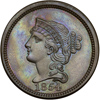 |
1854. Pattern Cent. Bronze, plain edge, Original, Judd-161, Pollock-187, Rarity-4. PCGS graded Proof 64 Brown. This one boasts hints of brightly colored toned on both sides, with hints of blue and purple tucked in the devices. A beauty that boasts clean surfaces and excellent eye appeal. Fully struck and free of hairlines or similar annoyances.
Estimated Value $800 - 1,000.
From the Benson collection and purchased from Ira S. Reed on July 28, 1945 for $10.00.
View details and enlarged photos
| Realized
$2,530 |
Lot 1787 |
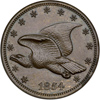 |
1854. Pattern Cent. Bronze, plain edge, Original, Judd-164, Pollock-189, Rarity-6. PCGS graded Proof 65 Brown. The reverse of this coin is entirely double struck, with a major shift of about 10 degrees clockwise for the second strike. Most of the reverse lettering and devices clearly show major rotation doubling. No sign of doubling on the obverse. We suspect that the coiner had noticed that these patterns were not striking up well (see the coin at the Harry Bass Foundation) and most are flat on the edge of the eagle's wing and on the wreath. Perhaps the coiner slightly rotated the reverse die after the first strike, in order to equalize the striking pressure on all the devices. This gave the wing a chance to be fully struck, and the reverse wreath was also brought up fully on the reverse in the process. A very similar coin with a double struck reverse was sold in Melnick's July 1982 sale, lot 45, which is obviously a different specimen as this coin was purchased in the mid 1940s.
Lovely medium brown in color, with traces of original color on both sides. PCGS has graded 7 this high in all the color combinations, with just 2 coins graded higher, both as PR-66 Brown. An impressive, and fully struck, example of this popular pattern issue which borrowed from Gobrecht's flying eagle pattern dollars.
The double striking feature would make an excellent article for publication, as there are likely more double struck specimens out there, and this is apparently deliberate as few are known, and at least two show the double striking on the reverse.
Estimated Value $900 - 1,100.
From the Benson collection and purchased from an unknown source on April 27, 1945 for $7.50.
View details and enlarged photos
| Realized
$3,105 |
Lot 1788 |
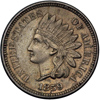 |
1859 Pattern Cent. Copper-nickel, plain edge. Judd-227. Pollock-271 Rarity-6. Proof 60. Nice color and surfaces, although we note a minor speck in the shield on the reverse.
Estimated Value $750 - 1,000.
View details and enlarged photos
| Realized
$920 |
Lot 1789 |
 |
1859 Pattern Half Dollar. Silver, reeded edge. Judd-235. Pollock-282, Rarity-5. PCGS graded Proof 64. Toned with irregular shades of milky gray with hints of vibrant colors mixed in as well, save for an area of steel gray on the lower right obverse. Similar on the reverse, with medium hazy gray around the periphery and a dark brownish gold area on the eagle and shield. As to the strike, it is full and complete on all the minute details on both sides. Struck before the dies were lapped (see the lapped reverse Proof-63 also in this sale) and while the colors are a bit strange, some will find the vibrant hues on the obverse very desirable, others may not, and as always, we recommend close personal inspection or viewing the coin on our website prior to bidding. PCGS has graded 10 this high, with just 4 higher (all PR-65) of this pattern issue. Curiously, Dr. Benson had 2 specimens of this pattern (PCGS # 11960) .
Estimated Value $1,400 - 1,600.
From the Benson collection and purchased from Hollinbeck Stamp & Coin Co. as lot #1547 from a sale circa 1944-46.
View details and enlarged photos
Check results on similar lots
| Realized
$2,070 |
Lot 1790 |
 |
1859 Pattern Half Dollar. Silver, reeded edge. Judd-235. Pollock-282, Rarity-6. PCGS graded Proof 63. Steel gray at the centers with lovely peripheral toning on both sides of darker gray hues. The fields and devices do show minor hairlines from a past cleaning or wiping, common and expected for the grade, and these are not too detracting. Identifiable by a short rectangular planchet void (a short thread or piece of debris on the coin at the time of striking) in the field inside of the eleventh and twelfth stars. Sharp on most of the devices, but we note a lack of definition on Liberty's hand on her shield, and the reverse die was lapped, breaking the ribbon above the eagle's head from over polishing the dies. Sharp on the reverse, including the eagle's claws, arrows, and ribbon over the shield. A mid-range grade example of this popular Paquet design (PCGS # 11960) .
Estimated Value $1,200 - 1,500.
From the Benson collection and purchased from an unknown source circa 1945.
View details and enlarged photos
Check results on similar lots
| Realized
$1,840 |
Lot 1791 |
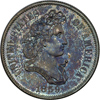 |
1859 Pattern Half Dollar. Silver, reeded edge. Judd-237. Pollock-293, Rarity-4. PCGS graded Proof 64. Gorgeous toning on both sides of an irregular crackle pattern that ranges from medium gray to a pretty shade of blue. We suspect that this coin was stored in the Hollinbeck paper envelope for that last 55 years or so, and this environment generated the toning seen today. It would be most difficult to attempt to describe the pattern of this toning precisely, so we'll leave that to the photograph and webpage. Regardless, the coin shows well with its blue and gray tones and sharp strike. A few faint hairlines can be found, but these are not detracting. PCGS in their Population Report show 7 graded this high, with 3 higher as PR-65 and 3 at the top as PR-66 (PCGS # 11966) .
Estimated Value $1,400 - 1,600.
From the Benson collection and purchased from Hollinbeck Stamp & Coin Co. as lot #1548 from a sale circa 1944-46.
View details and enlarged photos
Check results on similar lots
| Realized
$1,840 |
Lot 1792 |
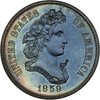 |
1859 Pattern Half Dollar. Silver, reeded edge. Judd-241. Pollock-297, Rarity-4. PCGS graded Proof 65. A stunning coin that boasts rich deep blue toning throughout with an arc of lighter sunset colors on the left side of the obverse and reverse. Boldly struck by the dies, with no a whisper of weakness to be found. We recommend close examination of the surfaces because there are faint roller lines on in the fields, these are not hairlines, but were caused when the planchets were being rolled and drawn through the Mint's huge mills. The surfaces are truly immaculate, without spot, trial or tribulation to be found. Thus, PCGS awarded this coin a full gem grade, PR-65, and one of just 2 coins graded this high of Judd-241. NGC has graded 4 as high as PF-65, also with none graded higher. If you demand the finest, and love toned coins, then here is a worthy coin to acquire (PCGS # 11978) .
Estimated Value $2,500 - 3,000.
From the Benson collection and purchased from Hollinbeck Stamp & Coin Company as lot #1550 from a sale circa 1944-46.
View details and enlarged photos
Check results on similar lots
| Realized
$3,853 |
Lot 1793 |
 |
1859 Pattern Half Dollar. Silver, reeded edge. Judd-241. Pollock-297, Rarity-4. PCGS graded Proof 61. Dipped long ago and still a bit bright, with touches of gold toning starting to form around the periphery. Moderate hairlines in the fields, which account for the moderate grade. Sharply struck by the dies, and popular for the wreath of cereals reverse (PCGS # 11978) .
Estimated Value $800 - 1,000.
From the Benson collection and purchased from Ira S. Reed as lot #891 from his sale of May 27, 1944 at $2.00.
View details and enlarged photos
Check results on similar lots
| Realized
$1,265 |
Lot 1794 |
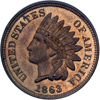 |
1863 Pattern Cent. Bronze, plain edge. Judd-299. Pollock-359 Rarity-3. PCGS graded Proof 65 Red & Brown. A lovely example of what later became the regular issue in late 1864, however, the reverse die was rotated for a medal turn. Faded, but just a little, from the original bright mint red color.
Estimated Value $1,500 - 1,800.
View details and enlarged photos
| Realized
$2,530 |
Lot 1795 |
 |
1863 Pattern Two Cents. Bronze, plain edge. Judd-305. Pollock-370, Rarity-4. Washington Head. PCGS graded Proof 64 Brown. Substantial traces of mint red in the fields, and the balance is toned a light brown. Boldly struck on all the devices. The textured light brown color is quite alluring. The Father of our Country--George Washington--is placed proudly on the obverse of this pattern issue. On the reverse we see a wreath of wheat surrounding 2 CENTS at the center, and the name of our country at the periphery. James Pollock, Director of the Mint was weary of working with nickel as an alloy, which was hard to melt and sometimes in short supply. Large quantities of nickel were required for cent production, and the toughness of nickel quickly broke cent dies. Pollock proposed using a new French bronze alloy, which was employed on this pattern issue, the combination of 95 percent copper, 3 percent tin and 2 percent zinc as a replacement for the current 88 percent copper and 12 percent nickel used in the copper-nickel cents. Pollock hoped this would end the Mint's use of nickel as an alloy. The French bronze alloy was accepted, and in 1864 Indian cents were changed from the copper nickel combination to the new bronze alloy. Shortly after this was coined, the Two Cent piece was adopted in 1864 using the same French bronze alloy seen here.
Pollock had won out and the use of nickel as an alloy would be shelved, but only for a brief time, by 1865 a Three Cent coin of nickel was authorized, and soon a Five Cent coin of nickel followed in 1866 both of which were alloyed 25% nickel and 75% copper, and Wharton's nickel mines remained in operation and vastly profitable (PCGS # 60460) .
Estimated Value $1,300 - 1,500.
From the Benson collection and purchased from Ira S. Reed on April 27, 1945 for $7.50.
View details and enlarged photos
Check results on similar lots
| Realized
$1,725 |
Lot 1796 |
 |
1863 Pattern Two Cents. Bronze, plain edge. Judd-305. Pollock-370, Rarity-4. Washington Head. PCGS graded Proof 63 Brown. George Washington is placed proudly on the obverse of this pattern issue. On the reverse we see a wreath of wheat with 2 CENTS at the center, surrounded by the name of our country. James Pollock, Director of the Mint was weary of working with nickel as an alloy, which was hard to melt and sometimes in short supply. Large quantities were required for cent production, and the toughness of nickel quickly broke cent dies. Pollock proposed using a new French bronze alloy, which was employed on this pattern issue, the combination of 95 percent copper, 3 percent tin and 2 percent zinc as a replacement for the current 88 percent copper and 12 percent nickel used in the copper-nickel cents. Pollock hoped this would end the Mint's use of nickel as an alloy. The French bronze alloy was accepted, and in 1864 Indian cents were changed from the copper nickel combination to the new bronze alloy. On this particular coin, we note that the surfaces show minor roughness in small areas on both sides, perhaps the alloy was not properly mixed. One tick is seen on Washington's bust, and the coin boasts a pleasing reddish brown color. Sharply struck and appealing for the moderate grade. Shortly after this was coined, the Two Cent piece was adopted in 1864 using the same French bronze alloy seen here (PCGS # 60460) .
Estimated Value $800 - 1,000.
From the Benson collection and purchased from Ira S. Reed on July 23, 1945 for $10.
View details and enlarged photos
Check results on similar lots
| Realized
$1,610 |
Lot 1797 |
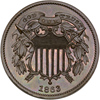 |
1863 Pattern Two Cents. Bronze, plain edge. Judd-312. Pollock-377, Rarity-4. PCGS graded Proof 65 Brown. One of the finest graded of this issue, PCGS has graded 8 this high in brown, with just 2 graded higher in the brown or other categories. The surfaces are simply superb, with rich tawny brown with hints of original red in the mirror fields near the devices. Free of spots or other detractions that often mar copper. We are uncertain how much this coin weighs as it is certified, and thus don't know which of the three different planchet weights this one is. A glorious example for the numismatist to put away (PCGS # 60467) .
Estimated Value $1,500 - 1,700.
From the Benson collection and purchased from Ira S. Reed's auction of April 27, 1945, lot 412 for $7.50.
View details and enlarged photos
Check results on similar lots
| Realized
$2,070 |
Lot 1798 |
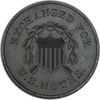 |
1863 Pattern Dime. Billon, plain edge. Judd-326a. Pollock-394, Rarity-7. PCGS graded Proof 64. A rare pattern issue that is seldom offered in any grade. PCGS has graded a total of 10, 2 as PR-63, 6 as PR-64 and 2 as PR-65. These were struck in billon, which is a combination of 75 percent copper and 25 percent silver, and the color appears like a normal copper cent, with the silver more a matter of faith than appearance. The devices are sharp on the simple design. A very choice example of this short-lived Postage Currency coinage (PCGS # 60485) .
Estimated Value $1,000 - 1,250.
From the Benson collection and purchased from Hollinbeck Stamp & Coin Company from their auction of December 8, 1945 as lot 1341 for $9.
View details and enlarged photos
Check results on similar lots
| Realized
$2,875 |
Lot 1799 |
 |
1864 Pattern Two Cents. Copper-nickel, plain edge. Judd-371. Pollock-440, Rarity-6. PCGS graded Proof 65. Lighter gold in color than the French bronze alloy, with the devices especially frosty against the pristine mirror fields. The obverse is very clean for the grade, but the reverse has some minor spots, one over the first A of AMERICA, another above the I of that word and a couple on or inside the wreath. A lovely gem for the specialist and one that is tied for the finest graded by PCGS with 6 in all seen this high of this rare pattern issue. This is the regular dies trial piece, with the large motto on the obverse, but is struck in the experimental copper nickel alloy (88 percent copper, 12 percent nickel) and the coin is slightly magnetic (PCGS # 60541) .
Estimated Value $1,700 - 2,000.
From the Benson collection and purchased from Ira S. Reed from his auction of April 27, 1945 as lot 453 for $12.50.
View details and enlarged photos
Check results on similar lots
| Realized
$3,220 |
Lot 1800 |
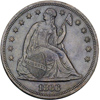 |
1866 Pattern Dollar. Copper, reeded edge. Judd-541. Pollock-606. Proof 60 +. Medium brown in color and we note a minor scrape up by the motto on right.
Estimated Value $3,000 - 4,000.
View details and enlarged photos
| Unsold |
Lot 1801 |
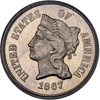 |
1867 Pattern Five Cents. Nickel, plain edge. Judd-566. Pollock-627. PCGS graded Proof 64. A splendid example of this pattern issue, the surfaces are bright and fresh and show none of the usual carbon flecks or flyspecks. Bold throughout. Housed in an older green insert PCGS holder (PCGS # 60776) .
Estimated Value $1,500 - 2,000.
View details and enlarged photos
Check results on similar lots
| Unsold |
Lot 1802 |
 |
1867 Pattern Five Cents. Nickel, plain edge. Judd-570. Pollock-638. High rarity-5. PCGS graded Proof 63. Hazy gray surfaces on both sides from storage but no problem contact marks are present. One faded spot in the left reverse field by the 5, and worth inspecting. The design is that of the Three Cent nickel, enlarged to a nickel format, the reverse with a lovely wreath and the denomination at the center, with IN GOD WE TRUST in small letters at the top. PCGS in their Population Report note 5 graded this high with 10 in higher grades (PCGS # 60780) .
Estimated Value $1,300 - 1,500.
From the Benson collection and purchased from Ira S. Reed on July 28, 1945 for $10.
View details and enlarged photos
Check results on similar lots
| Realized
$1,610 |
Lot 1803 |
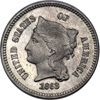 |
1868 Pattern Cent. Nickel, plain edge. Judd-608. Pollock-673, Rarity-5. PCGS graded Proof 64. Frosted on the devices, with well mirrored fields throughout. Slight nickel haze and a few minute specks, mostly on the reverse. This appears to be Pollock variety-1, with a slightly recut date. Struck at the request of Congress, these patterns were issued as a proposal to redeem all the tattered and hated Fractional currency notes then in circulation. Luckily for the Mint, the proposal was not accepted, and nickel coinage remained only in the three and five cent denominations (PCGS # 60820) .
Estimated Value $800 - 1,000.
From the Benson collection and purchased from Hollinbeck Stamp & Coin Company's auction circa 1944-46 lot 1553 for an unknown amount.
View details and enlarged photos
Check results on similar lots
| Realized
$1,495 |
|
|